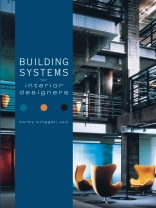The first desk reference on technical building systems for interior
designers
Building Systems for Interior Designers is the first book
to explain technical building systems and engineering issues in a
clear and accessible way to interior designers. The technical
knowledge and vocabulary presented here allow interior designers to
communicate more effectively with architects, engineers, and
contractors while collaborating on projects, leading to more
accurate solutions for problems related to a broad range of other
building considerations with an impact on interior design.
Information on sustainable design is integrated throughout the
book, making it a relevant tool for current and emerging trends in
building design.
Written in a straightforward, nontechnical style that maintains
depth and accuracy, this book is the first complete text applicable
to interior design courses and provides thorough preparation for
the NCIDQ exam. Engaging, clear illustrations support the text,
which is accessible to those without a math or physics
background.
Topics covered include:
* Heating and air conditioning systems
* Environmental issues
* Water and waste
* Thermal comfort
* HVAC systems
* Electricity
* Lighting
* Security and communications systems
* Fire safety
* Transportation systems
With numerous case examples illustrating how interior designers
apply this material in the real world, Building Systems for
Interior Designers is a valuable book for students, as well as
a practical desktop reference for professionals.
Content from this book is available as an online continuing
professional education course at href=’http://www.wiley.com/Wiley CDA/Section/id-320255.html#fire_safety’>http://www.wiley.com/Wiley CDA/Section/id-320255.html#fire_safety.
Wiley CPE courses are available on demand, 24 hours a day, and are
approved by the American Institute of Architects.
Jadual kandungan
Preface.
Acknowledgments.
PART I: THE BIG PICTURE.
Chapter 1 Natural Resources.
Chapter 2 Building Site Conditions.
Chapter 3 Designing for Building Functions.
Chapter 4 The Human Body and the Built Environment.
Chapter 5 Building Codes.
PART II: WATER AND WASTES.
Chapter 6 Sources of Water.
Chapter 7 Water Quality.
Chapter 8 Water Distribution.
Chapter 9 Hot Water.
Chapter 10 Waste Plumbing.
Chapter 11 Treating and Recycling Water.
Chapter 12 Recycling Solid Wastes.
Chapter 13 Plumbing Fixtures.
Chapter 14 Designing Bath and Toilet Rooms.
PART III: THERMAL COMFORT.
Chapter 15 Principles of Thermal Comfort.
Chapter 16 Thermal Capacity and Resistance.
Chapter 17 Humidity.
Chapter 18 Mechanical Engineering Design Process.
Chapter 19 Indoor Air Contaminants.
Chapter 20 Designing for Indoor Air Quality.
Chapter 21 Ventilation.
Chapter 22 Fenestration.
Chapter 23 Solar Heating.
PART IV: HEATING AND COOLING SYSTEMS.
Chapter 24 Heating Systems.
Chapter 25 Cooling.
Chapter 26 Heating, Ventilating, and Air-Conditioning (HVAC)
Systems.
PART V: ELECTRICITY.
Chapter 27 How Electrical Systems Work.
Chapter 28 Electrical Service Equipment.
Chapter 29 Electrical Circuit Design.
Chapter 30 Electrical Wiring and Distribution.
Chapter 31 Receptacles and Switches.
Chapter 32 Residential Appliances.
PART VI: LIGHTING.
Chapter 33 Daylighting.
Chapter 34 Lighting Design.
Chapter 35 Lighting for Specific Spaces.
PART VII: SECURITY AND COMMUNICATIONS SYSTEMS.
Chapter 36 Communications and Control Systems.
Chapter 37 Securing the Building.
Chapter 38 Systems for Private Residences.
Chapter 39 Other Security and Communications Applications.
Chapter 40 Office Communications Systems.
PART VIII: FIRE SAFETY.
Chapter 41 Principles of Fire Safety.
Chapter 42 Design for Fire Safety.
Chapter 43 Escape Routes.
Chapter 44 Limiting Fuels.
Chapter 45 Fire Suppression.
Chapter 46 Fire Detection and Alarms.
PART IX: CONVEYING SYSTEMS.
Chapter 47 Elevators.
Chapter 48 Escalators.
Chapter 49 Materials Handling.
PART X: ACOUSTICS.
Chapter 50 Acoustic Principles.
Chapter 51 Acoustic Design.
Chapter 52 Sound Absorption Within a Space.
Chapter 53 Sound Transmission Between Spaces.
Chapter 54 Acoustic Applications.
Chapter 55 Electronic Sound Systems.
Index.
Mengenai Pengarang
CORKY BINGGELI, ASID, is a principal at Corky Binggeli Interior Design in Boston and an adjunct lecturer at Wentworth Institute of Technology in Boston.












